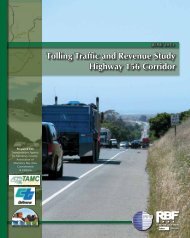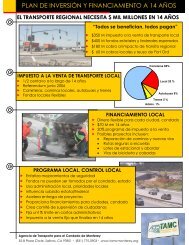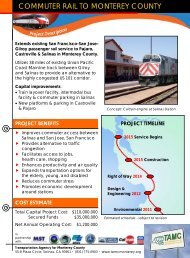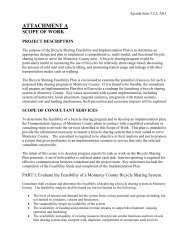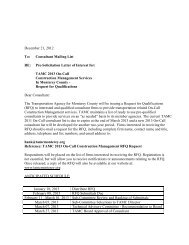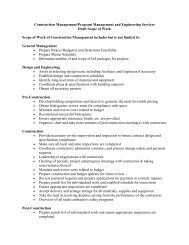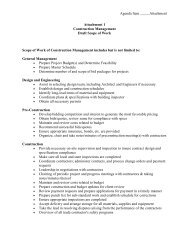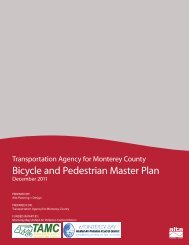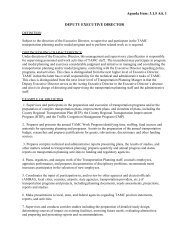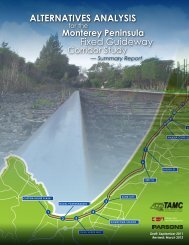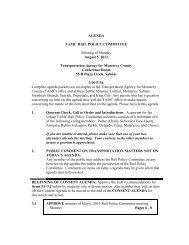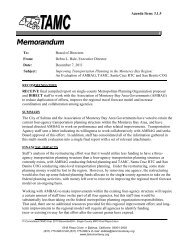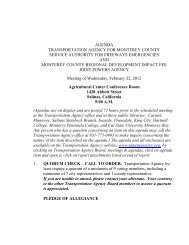- Page 4 and 5:
DRAFTCALTRAIN EXTENSIONTO MONTEREY
- Page 6 and 7:
CALTRAIN EXTENSION TO MONTEREY COUN
- Page 8 and 9:
CALTRAIN EXTENSION TO MONTEREY COUN
- Page 10 and 11:
CALTRAIN EXTENSION TO MONTEREY COUN
- Page 12 and 13:
CALTRAIN EXTENSION TO MONTEREY COUN
- Page 14 and 15:
CALTRAIN EXTENSION TO MONTEREY COUN
- Page 16 and 17:
CALTRAIN EXTENSION TO MONTEREY COUN
- Page 18 and 19:
CALTRAIN EXTENSION TO MONTEREY COUN
- Page 20 and 21:
CALTRAIN EXTENSION TO MONTEREY COUN
- Page 22 and 23:
CALTRAIN EXTENSION TO MONTEREY COUN
- Page 24 and 25:
CALTRAIN EXTENSION TO MONTEREY COUN
- Page 26 and 27:
CALTRAIN EXTENSION TO MONTEREY COUN
- Page 28 and 29:
CALTRAIN EXTENSION TO MONTEREY COUN
- Page 30 and 31:
CALTRAIN EXTENSION TO MONTEREY COUN
- Page 32 and 33:
CALTRAIN EXTENSION TO MONTEREY COUN
- Page 34 and 35:
CALTRAIN EXTENSION TO MONTEREY COUN
- Page 36 and 37:
CALTRAIN EXTENSION TO MONTEREY COUN
- Page 38 and 39:
CALTRAIN EXTENSION TO MONTEREY COUN
- Page 40 and 41:
CALTRAIN EXTENSION TO MONTEREY COUN
- Page 42 and 43:
CALTRAIN EXTENSION TO MONTEREY COUN
- Page 44 and 45:
CALTRAIN EXTENSION TO MONTEREY COUN
- Page 46 and 47:
CALTRAIN EXTENSION TO MONTEREY COUN
- Page 48 and 49:
CALTRAIN EXTENSION TO MONTEREY COUN
- Page 50 and 51:
CALTRAIN EXTENSION TO MONTEREY COUN
- Page 52 and 53:
CALTRAIN EXTENSION TO MONTEREY COUN
- Page 54 and 55:
CALTRAIN EXTENSION TO MONTEREY COUN
- Page 56 and 57:
CALTRAIN EXTENSION TO MONTEREY COUN
- Page 58 and 59:
CALTRAIN EXTENSION TO MONTEREY COUN
- Page 60 and 61:
CALTRAIN EXTENSION TO MONTEREY COUN
- Page 62 and 63:
CALTRAIN EXTENSION TO MONTEREY COUN
- Page 64 and 65:
CALTRAIN EXTENSION TO MONTEREY COUN
- Page 66 and 67:
CALTRAIN EXTENSION TO MONTEREY COUN
- Page 68 and 69:
CALTRAIN EXTENSION TO MONTEREY COUN
- Page 70 and 71:
CALTRAIN EXTENSION TO MONTEREY COUN
- Page 72 and 73:
CALTRAIN EXTENSION TO MONTEREY COUN
- Page 74 and 75:
CALTRAIN EXTENSION TO MONTEREY COUN
- Page 76 and 77:
CALTRAIN EXTENSION TO MONTEREY COUN
- Page 78 and 79:
CALTRAIN EXTENSION TO MONTEREY COUN
- Page 80 and 81:
CALTRAIN EXTENSION TO MONTEREY COUN
- Page 82 and 83:
CALTRAIN EXTENSION TO MONTEREY COUN
- Page 84 and 85:
CALTRAIN EXTENSION TO MONTEREY COUN
- Page 86 and 87:
CALTRAIN EXTENSION TO MONTEREY COUN
- Page 88 and 89:
CALTRAIN EXTENSION TO MONTEREY COUN
- Page 90 and 91:
CALTRAIN EXTENSION TO MONTEREY COUN
- Page 92 and 93:
CALTRAIN EXTENSION TO MONTEREY COUN
- Page 94 and 95:
CALTRAIN EXTENSION TO MONTEREY COUN
- Page 96 and 97:
CALTRAIN EXTENSION TO MONTEREY COUN
- Page 98 and 99:
CALTRAIN EXTENSION TO MONTEREY COUN
- Page 100 and 101:
CALTRAIN EXTENSION TO MONTEREY COUN
- Page 102 and 103:
CALTRAIN EXTENSION TO MONTEREY COUN
- Page 104 and 105:
CALTRAIN EXTENSION TO MONTEREY COUN
- Page 106 and 107:
CALTRAIN EXTENSION TO MONTEREY COUN
- Page 108 and 109:
CALTRAIN EXTENSION TO MONTEREY COUN
- Page 110 and 111:
CALTRAIN EXTENSION TO MONTEREY COUN
- Page 112 and 113:
CALTRAIN EXTENSION TO MONTEREY COUN
- Page 114 and 115:
CALTRAIN EXTENSION TO MONTEREY COUN
- Page 116 and 117:
CALTRAIN EXTENSION TO MONTEREY COUN
- Page 118 and 119:
CALTRAIN EXTENSION TO MONTEREY COUN
- Page 120 and 121:
CALTRAIN EXTENSION TO MONTEREY COUN
- Page 122 and 123:
CALTRAIN EXTENSION TO MONTEREY COUN
- Page 124 and 125:
CALTRAIN EXTENSION TO MONTEREY COUN
- Page 126 and 127:
CALTRAIN EXTENSION TO MONTEREY COUN
- Page 128 and 129:
CALTRAIN EXTENSION TO MONTEREY COUN
- Page 130 and 131:
CALTRAIN EXTENSION TO MONTEREY COUN
- Page 132 and 133:
CALTRAIN EXTENSION TO MONTEREY COUN
- Page 134 and 135:
CALTRAIN EXTENSION TO MONTEREY COUN
- Page 136 and 137:
CALTRAIN EXTENSION TO MONTEREY COUN
- Page 138 and 139:
CALTRAIN EXTENSION TO MONTEREY COUN
- Page 140 and 141:
CALTRAIN EXTENSION TO MONTEREY COUN
- Page 142 and 143:
CALTRAIN EXTENSION TO MONTEREY COUN
- Page 144 and 145:
CALTRAIN EXTENSION TO MONTEREY COUN
- Page 146 and 147:
CALTRAIN EXTENSION TO MONTEREY COUN
- Page 148 and 149:
CALTRAIN EXTENSION TO MONTEREY COUN
- Page 150 and 151:
CALTRAIN EXTENSION TO MONTEREY COUN
- Page 152 and 153:
CALTRAIN EXTENSION TO MONTEREY COUN
- Page 154 and 155:
CALTRAIN EXTENSION TO MONTEREY COUN
- Page 156 and 157:
CALTRAIN EXTENSION TO MONTEREY COUN
- Page 158 and 159:
CALTRAIN EXTENSION TO MONTEREY COUN
- Page 160 and 161:
CALTRAIN EXTENSION TO MONTEREY COUN
- Page 162 and 163:
CALTRAIN EXTENSION TO MONTEREY COUN
- Page 164 and 165:
CALTRAIN EXTENSION TO MONTEREY COUN
- Page 166 and 167:
CALTRAIN EXTENSION TO MONTEREY COUN
- Page 168 and 169:
CALTRAIN EXTENSION TO MONTEREY COUN
- Page 170 and 171:
CALTRAIN EXTENSION TO MONTEREY COUN
- Page 172 and 173:
CALTRAIN EXTENSION TO MONTEREY COUN
- Page 174 and 175: CALTRAIN EXTENSION TO MONTEREY COUN
- Page 176 and 177: CALTRAIN EXTENSION TO MONTEREY COUN
- Page 178 and 179: CALTRAIN EXTENSION TO MONTEREY COUN
- Page 180 and 181: CALTRAIN EXTENSION TO MONTEREY COUN
- Page 182 and 183: CALTRAIN EXTENSION TO MONTEREY COUN
- Page 184 and 185: CALTRAIN EXTENSION TO MONTEREY COUN
- Page 186 and 187: CALTRAIN EXTENSION TO MONTEREY COUN
- Page 188 and 189: CALTRAIN EXTENSION TO MONTEREY COUN
- Page 190 and 191: CALTRAIN EXTENSION TO MONTEREY COUN
- Page 192 and 193: CALTRAIN EXTENSION TO MONTEREY COUN
- Page 194 and 195: CALTRAIN EXTENSION TO MONTEREY COUN
- Page 196 and 197: CALTRAIN EXTENSION TO MONTEREY COUN
- Page 198 and 199: CALTRAIN EXTENSION TO MONTEREY COUN
- Page 200 and 201: CALTRAIN EXTENSION TO MONTEREY COUN
- Page 202 and 203: CALTRAIN EXTENSION TO MONTEREY COUN
- Page 204 and 205: CALTRAIN EXTENSION TO MONTEREY COUN
- Page 206 and 207: CALTRAIN EXTENSION TO MONTEREY COUN
- Page 208 and 209: CALTRAIN EXTENSION TO MONTEREY COUN
- Page 210 and 211: CALTRAIN EXTENSION TO MONTEREY COUN
- Page 212 and 213: CALTRAIN EXTENSION TO MONTEREY COUN
- Page 214 and 215: CALTRAIN EXTENSION TO MONTEREY COUN
- Page 216 and 217: CALTRAIN EXTENSION TO MONTEREY COUN
- Page 218 and 219: CALTRAIN EXTENSION TO MONTEREY COUN
- Page 220 and 221: CALTRAIN EXTENSION TO MONTEREY COUN
- Page 222 and 223: CALTRAIN EXTENSION TO MONTEREY COUN
- Page 226 and 227: CALTRAIN EXTENSION TO MONTEREY COUN
- Page 228 and 229: CALTRAIN EXTENSION TO MONTEREY COUN
- Page 230 and 231: CALTRAIN EXTENSION TO MONTEREY COUN
- Page 232 and 233: CALTRAIN EXTENSION TO MONTEREY COUN
- Page 234 and 235: CALTRAIN EXTENSION TO MONTEREY COUN
- Page 236 and 237: CALTRAIN EXTENSION TO MONTEREY COUN
- Page 238 and 239: CALTRAIN EXTENSION TO MONTEREY COUN
- Page 240 and 241: CALTRAIN EXTENSION TO MONTEREY COUN
- Page 242 and 243: CALTRAIN EXTENSION TO MONTEREY COUN
- Page 244 and 245: CALTRAIN EXTENSION TO MONTEREY COUN
- Page 246 and 247: CALTRAIN EXTENSION TO MONTEREY COUN
- Page 248 and 249: CALTRAIN EXTENSION TO MONTEREY COUN
- Page 250 and 251: CALTRAIN EXTENSION TO MONTEREY COUN
- Page 252 and 253: CALTRAIN EXTENSION TO MONTEREY COUN
- Page 254 and 255: CALTRAIN EXTENSION TO MONTEREY COUN
- Page 256 and 257: CALTRAIN EXTENSION TO MONTEREY COUN
- Page 258 and 259: CALTRAIN EXTENSION TO MONTEREY COUN
- Page 260 and 261: CALTRAIN EXTENSION TO MONTEREY COUN
- Page 262 and 263: CALTRAIN EXTENSION TO MONTEREY COUN
- Page 264 and 265: CALTRAIN EXTENSION TO MONTEREY COUN



